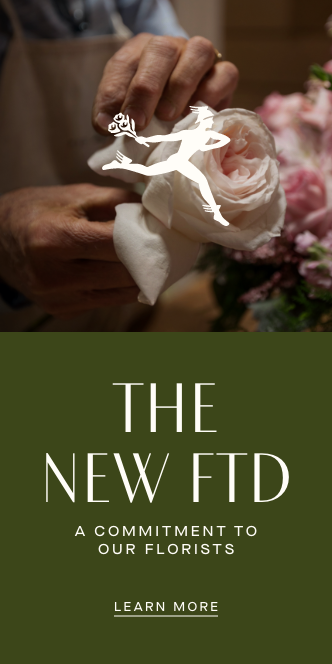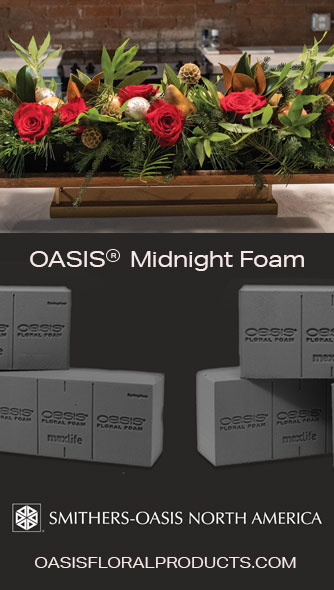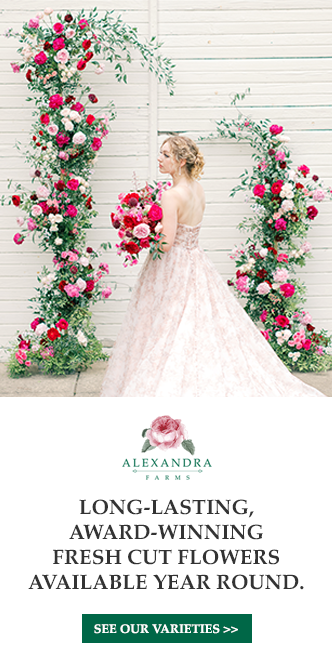Tips for understanding how colors interact, to elevate not only your designs but also your professionalism
Text and floral design by Amy Balsters
The Floral Coach
Alexandria, Va.
Photo by Akbar Sayed Photography
You can gingerly process and handle your flowers. You can hand-select the most beautiful, novelty blooms. You can painstakingly fuss over stem placement in a bouquet—but color is what any bride, client or recipient will first notice about a flower arrangement. Color is what makes a design pop in an Instagram photo or garner a cult-like following on Pinterest. Color can evoke emotional responses, reflect a season or holiday, represent a culture or community, and carry deep personal meaning to us all.

Color theory allows us to assess, observe and understand how colors interact. Once we understand these interactions, we can leverage them to create pleasing, intentional color stories for our clients, be they a soft, earthy ambience for a wedding, a flash of color in a hotel lobby or a romantic gesture in a vase arrangement.
Even if you have an inherent “knack” or sense of color stories and palettes, knowing color theory can be a great asset, regardless on your skill level. It can help you accurately meet clients’ wants and expectations; improve communication with your wholesale sales rep; make substitutions with ease; and help educate your staff, ensuring they produce and deliver your style.
Color theory is a robust, complicated study, and it can even be quite controversial. So, allow me to share four key tips that have helped me use color theory to elevate my floral design skills over the years.
TIP 1: Use a Color Wheel

I’m a firm believer that a color wheel is an essential tool in any floral designers’ palette-building process. Simple color wheels are composed of six segments: the three primary colors (red, yellow and blue) and the three secondary colors (orange, green and violet). A 12-segment color wheel adds tertiary, or intermediate, colors (like red-orange, yellow-green, blue-violet, etc.). The more segments, or spokes, a color wheel has, the more intermediate colors it will comprise. I prefer a minimum of 12 colors on a wheel, or, even better, an 18-segment color wheel. It has enough specificity without being too detailed and overwhelming.
My favorite color wheels also you tints, tones and shades of the primary, secondary and tertiary hues (we’ll dig into this in a bit). While you can use a digital version, I prefer a color wheel I can hold in my hand, so I can lay flowers directly on it or next to it. It also enables me to define color harmonies (the basic of which are monochromatic, analogous, complementary, split complementary and triadic) based on a single specific color, regardless of whether that color is a primary, secondary or tertiary color, or a tint, tone or shade of that color. This helps me understand the true color of that flower, which informs how I build palettes.

Keep in mind, there is no perfect color tool. Most color wheels are made for mediums like print or paint. And unlike paint, we can’t mix until we get the perfect color flower. Furthermore, we work with changing perishable products. Roses of the same variety can vary in undertone from grower to grower, largely depending on grower’s location and that location’s climate and soil conditions. In addition, flower color is not constant and can change as blooms develop and age. Lighting also greatly impacts flowers, causing the colors to appear different in various settings (e.g., natural outdoor light versus a lighting in a ballroom). After all, color is a quality of light. All of these factors contribute to the unique challenge of floral color theory; however, a color wheel still helps us understand a flower’s color objectively so that we can make intentional decisions about how to build color palettes that are pleasing to the eyes.
TIP 2: Understand the Core Color Principles
Color can be understood through three main principles: hue, value and saturation. Hue and color can sometimes be used interchangeably, but while all hues are colors, not all colors are hues, Hues are, technically, pure primary, secondary and tertiary colors that have not been changed in value or saturation (we’ll dig into this in a moment). So, if you look at a red, orange or even red-orange segment on the color wheel, that is a hue.

Hues violet-red, red and orange-red are softened with the addition of tints peach, apricot and blush and the tone rust.
All colors have a hue (I like to call it “core hue”) from which they are derived. Any color that deviates from those pure colors on the color wheel can still be traced back to a “core hue.” The deviations can be understood as value and saturation.
Value is the lightness or darkness of a color, expressed by the addition of white (tint) or black (shade) to a color. Take the color red, for example. Add white, and you get pink. Add black, and you get burgundy. The color pink is a tint of the hue red, and the color burgundy is a shade of the hue red.
Around and around the color wheel, you can apply this process.

Red + white = the color pink (a tint). Red + black = the color burgundy (a shade). Similarly, blue-green + white = the color robin’s egg, and blue-green + black = the color jade.
Common tints are like pastels: peach, butter yellow, baby blue, sage green, lavender, etc. Common shades are like jewel tones: eggplant, maroon, gold, hunter green, navy blue, plum, etc.

Coral, peach and dusty pink are tints, tones and shades of the hues violet-red, red and orange-red. Together, they create a soft and beautiful blended palette.
Saturation refers to the intensity of a color. The hues on the color wheel have pure, unaltered intensity. They can be understood as vivid, clear, rich, intense and/or bright. You can change the intensity of a hue by adding gray (tone). Tonal colors can be understood as earthy, muddy, vintage, muted and understated (every color that’s popular right now!).

Red + gray = the color brick (a tone). Blue-green + gray = evergreen.
Saturation and value can simultaneously modify a hue, resulting in colors like dusty rose, mauve, “greige,” olive or rust, as illustrated in this graphic.

Hues can be modified in limitless combinations with varying amounts of white, black or gray. This results in the vast gamut of what we perceive as color.
When we understand how value and saturation affect a color, we can better select the right products for our palettes. When a customer wants peach, we can analyze if her request is more a tint of orange-red or of yellow-orange. Or does she mean blush, which is really just a tint of red, after all? When a wholesaler tells you, “I have a purple cremon for you!” well is it a true violet? Or is it a tone of red-violet that will look muddy and dull next to purple lisianthuses?
This is especially important when you determine how much of each color to choose for any given palette. Ratio and proportion tell us that it’s often best to consider a 10:30:60 ratio or the Fibonacci sequence 3/5/8 … (the Golden Ratio of approximately a 20:30:50) of any given color. But don’t just consider how much of the “core hue” is contained in any palette; be sure to account for its tints, tones and shades, as well.
Also consider the saturation of the palette. If all the flowers being used are pale and muted, you may need to add a bright saturated color to the palette for a much needed contrast, and vice versa.

Even polychromatic flower arrangements benefit from such ratios. Notice, there is the highest proportion of the red/orange-red family, even in the pink tints.
The tint of the pale sweet pea adds visual interest and softness to an otherwise loud palette.These principles can also guide your stem placement when arranging. Vibrant, pure hues tend to pop in arrangements. The darkness of tones and shades can recede in designs, creating depth. Tints aid transitions from one vibrant hue to another, softening otherwise loud, contrasting combinations.
TIP 3: Warm or Cool?
Temperature is a key consideration when analyzing and choosing colors. Temperature refers to undertones in a flower that lean toward either the warm side of the color wheel (reds, oranges and yellows) or the cool side (greens, blues and violets).

Warm and cool reds, violet-reds, and orange-reds blended together create contrast in a monochromatic palette.
Temperature becomes critical for many florists when using white. All white flowers are typically a “tint” of another hue because “pure white” doesn’t likely exist in the natural petals of most flowers. If a florist orders white flowers for a wedding, the flowers will likely arrive in varying forms of ivory, cream and/or even hints of pale yellow. This can be acceptable for some clients, but if there is an expectation of “pure classic white” (typically more cool-toned whites), a client might be upset that her flowers look “yellow.” In my online color theory course for florists, “Color Theory Confidence,” I created a “White Temperature Flower Guide” of more than 50 white flowers, so any florist using the guide can quickly design and order based on warm or cool whites.
Understanding temperature is important when working with any hue. A palette can quickly shift to muddy or confusing when not selecting an appropriate ratio of warm and cool colors. Temperature is often missed or left out of the color conversation, but it’s critical to know how to navigate this important aspect of color theory.
TIP 4: When in Doubt, Use a Color Harmony
Nature is my greatest inspiration for color, and it often proves a simple fact: Color harmonies work! When I look at a flower, I often observe color harmonies contained directly in the flowers themselves. Like a pansy, comprising a striking and beautiful combination of violet and yellow (complementary colors).
Don’t believe me? Take, for example, this bouquet, which is based on the double-complementary harmony yellow, green-yellow, violet, and red-violet.

You might be thinking, “Um, this is hardly the combo you mentioned in pansies.” Well, actually, it is. By utilizing tints, tones and shades of yellow and green-yellow, it creates a subtle, pleasing contrast with the soft violet larkspurs, tonal red-violet ‘Café Latte’ roses and sandy pink/lavender ‘Loli’ spray roses. It’s really just a variation on the yellow-and-violet complementary color harmony.
Color harmonies are often dismissed because they are usually depicted using the brightest, most saturated version of the colors to achieve that harmony. But when you are designing, you can include varying tints, tones, shades and temperatures of your “core hues” to add subtlety and blend colors without deviating from your color harmony.
Let’s look at a soft, pastel, spring version of this same color harmony.

By leaning on the tints of this blue-violet, violet, orange-yellow and yellow combination, this palette has been adapted to be light and soft while still embracing complementary contrast.
If I’m ever struggling to build a palette from the flowers in my cooler or can’t seem to make two colors “connect” visually, the color wheel and color harmonies are the first place I go. I assess my bloom (or blooms), finding the “core hue” the color is derived from. From there, I find it on the color wheel and explore different harmonies for that hue. Then I get to work, making sure to include some tints, tones and shades in my pull. It’s a surefire way to quickly and seamlessly build a stunning palette.
Conclusion
Color is complex, but as florists, we can use it to elevate our work and create a portfolio that stands out and catches the eyes. Furthermore, color theory is not only an aesthetics issue but also an economics one. With rising costs of doing business, it’s more important than ever that florists manage their costs well. When florists know how to create compelling color stories, they don’t have to rely on expensive flowers to do all the heavy lifting in a design. By using accessible, humble blooms, florists can still create on-trend, stunning work with color alone.




















